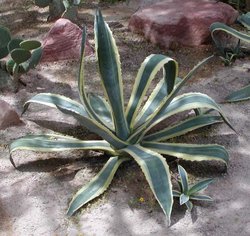Century plant
|
|
| Century Plant | ||||||||||||||
|---|---|---|---|---|---|---|---|---|---|---|---|---|---|---|
 Century plant | ||||||||||||||
| Scientific classification | ||||||||||||||
|
The Century Plant or Maguey (Agave americana) is an agave originally from Mexico but cultivated worldwide.
It has a spreading rosette (up to 9 m wide) of gray-green leaves up to 2 meters (6 ft) long, each with a spiny margin and a heavy spike at the tip. Its common name derives from its habit of only occasionally flowering, but when it does, the spike with a cyme of big yellow flowers, may reach up to 8 meters (25 ft) in height. The plant dies after flowering. The average life-span is around 25 years.
Cultivated varieties include the 'Marginata' with yellow stripes along the margins of each leaf, 'Mediopicta' with a central light band, and 'Striata' with multiple stripes along the leaves.
It is also known as the American aloe, although it is not related to the true aloes.
If the flower stem is cut without flowering, a sweet liquid called agua miel ("honey water") gathers in the heart of the plant. This may be fermented to produce the drink called pulque, which may then be distilled to produce mezcal. The leaves also yield fibres suitable for making rope, matting and coarse cloth. Both pulque and maguey fibre were important to the economy of pre-columbian Mexico. Production continues today to a much lesser extent.
Subspecies
- Agave americana var. americana
- Agave americana var. expansa
- Agave americana var. latifolia
- Agave americana var. marginata
- Agave americana var. medio-picta
- Agave americana var. oaxacensis
- Agave americana ssp. protamericana
- Agave americana var. striata
